
International Research Journal of Engineering and Technology (IRJET) e-ISSN:2395-0056
Volume: 12 Issue: 05 | May 2025 www.irjet.net p-ISSN:2395-0072


International Research Journal of Engineering and Technology (IRJET) e-ISSN:2395-0056
Volume: 12 Issue: 05 | May 2025 www.irjet.net p-ISSN:2395-0072
Nikita Gauda1 , Ruchi Bhati2 , Savi Band3 , Kumud Wasnik4
1Student,Dept of Computer Science and technology,Usha mittal institute of technology,Mumbai, Maharashtra
2Student,Dept of Computer Science and technology,Usha mittal institute of technology,Mumbai, Maharashtra
3Student,Dept of Computer Science and technology,Usha mittal institute of technology,Mumbai, Maharashtra
4HOD,Dept of Computer Science and technology,Usha mittal institute of technology,Mumbai, Maharashtra
ABSTRACT-Counterfeit notes are a growing issue that damages economic stability and destabilizes financial institutions around the world. Conventional methods of detecting counterfeit banknotes, being mostly visual, are not only time-consuming but also susceptible to human error. For the ordinary individual in everyday life, there is typically no means of checking a currency note's authenticity, making them more susceptible to fraud and financial loss. This problem requires a solution that is feasible and economically viable to allow all, professionals or not, to easily identify the counterfeit notes. To solve this urgent problem, we present an advanced Counterfeit Currency Detection System that integrates YOLOv5's ability to detect the prominent security features on banknotes and CNN (mobileNet V2) in identifying whether they are genuine or counterfeit. Our system is tailor-made for Indian rupee values of 500, 200, and 100 with the purpose of creating a standardized, real-time platform for examining the security features that characterize authentic notes from the counterfeits. Through the use of advanced deep learning methods, this system is sure to be precise and effective and thus an effective tool for identifying counterfeits. To be user-friendly and accessible, the system has a facility of audio feedback for blind individuals who can use its services. Given its emphasis on reliability, accessibility, and efficiency, this solution empowers individuals and communities by minimizing their potential to become victims of counterfeit money, thusleading toasecure financialsystem.
Keywords–Computer Vision, Counterfeit Currency Detection, Indian Currency, MobileNetV2, Real-Time Classification, Security Features, YOLOv5,Audio Output.
Identification of money has the most significant use of computervision,thatis,identificationandverificationof a country's bank notes. Counterfeit currency is defined as“imitationbanknotesproducedwithoutlegalsanction, designedtoreplicategenuinecurrency”(Interpol,2023) refer [17]. Because of globalization and increased crossbordertransactions,currencyexchangeacrosscountries has become rampant, hence calling for safe means of
identifying and verifying different currencies.Banknotes must be recognizable from both sides, even if they are damaged or torn, by these identification systems. The world is replete with money, and all of them have different patterns, texture, and size, hence identification is not a simple task, particularly for foreign exchange workers. Physical handling of money is prone to numerous risks such as misidentification and physical wear and tear. Having this in mind, the demand for automated systems that can identify and authenticate money effectively with minimal human interference is increasing.
One of the major challenges faced by global economies, including the Reserve Bank of India, is the increasing circulation of counterfeit currency (Reserve Bank of India, 2023) [21]. Every year, huge quantities of fake or torn currency are found, and this creates immense problemsforthebanks.Althoughelectronictransactions are on the increase, physical currency is still indispensable for day-to-day transactions. The systems used to identify banknotes are not always efficient, especially in shopping malls and banks where transactions take place frequently. The necessity of an effective, automated system to identify fake money has become urgent. The development in imaging technologies and machine learning offers the scope to create systems that are effective in determining the genuineness of banknotes, decreasing fake currency circulation and maintaining the validity of financial transactions
The core purpose of the current research work is to engineeranddevelopanefficientcurrencydetectionand verification system that can determine authentic and forged banknotes. The system would look to dig out prominent banknote security characteristics such as numerals, security thread, Guarantee clause, Ashoka EmblemandRBIlogoandthentrylabelingthemasfake or real in the most apt way possible. Using a deep learningobjectdetectionmodel,thesystem will then be able to recognize such features even on torn or creased banknotes.

International Research Journal of Engineering and Technology (IRJET) e-ISSN:2395-0056
Volume: 12 Issue: 05 | May 2025 www.irjet.net p-ISSN:2395-0072
Thestudy“IndianCurrencyNoteRecognitionSystem usingYOLOv3Methodology”byWafiaRarani,Vrushabh Rode, Chaitali Mahatme, Dhiraj Chavhan, Prof. Kalyani Gholap-.(2021)see[1]whichintroducesthedetectionof fake currency using YOLOv3, which is highly efficient in thedetectionoftinyobjectslikesecuritymarksinIndian currency.₹10,₹50,₹100,₹200,₹500,and₹2000arefed into the system through a 78-image database.The image processing techniques are tuned and the database is resizedaccordingtoYOLOv3'srequirement.Ittrainsthe model for 6000 epochs in a grid pattern to search for security features on many different scales. It is efficient whenitisdealingwithsmalldata,butthesystemisslow in training, too image data dependent, and has low data generalization problems. Although it is good, it is very slowandinaccurateincomparisontootherstate-of-theartmodels.
Building upon the challenges of YOLOv3 the research “YOLOv5-Based Web Application for Indian Currency NoteDetection”bySreeAshritDande,GowthamReddy Uppunuri, Dr. Ajay Singh Raghuvanshi (2022) see [11] presentsaYOLOv5-poweredweb-basedIndiancurrency detector. A dataset of various denominations was collected, augmented, and annotated before model training with a 70-30 train-validation split. The model was trained on an image size of 416, 30 epochs, and batch size of 32. Images are processed with a back-end on Flask, and a front-end is presented using HTML, CSS, and JavaScript to offer an interface-friendly structure.The model was very accurate with precision and recall of more than 0.99 for the majority of the denominations. The model has its limitations with its dependency on the GPU, limitation of data, and use in varying lighting conditions. The web application is biased towards visually impaired users using auditory feedback for improved usability and accessibility.
ShiftingfromYOLObasedapproachesthepaper“Fake Currency Detection Using Convolutional Neural Network”byAyushAntre,OmKalbhor,PratikJagdale, GaneshDhanne,Prof.NileshR.Sonawane(2023)see[7] utilizes CNNs to determine whether Indian currency is genuineorcounterfeit.The377imagedataset(₹10–₹2000) was recorded through mobile phones, 307 training images, and 70 testing images. Pre-processing consistedofgrayscale,Gaussianblur,edgedetection,and binary.Four-layer convolutional CNN, ReLU activation, and max-pooling were employed to extract hierarchical features. Binary cross-entropy loss and 1e-4 RMSprop learning rate were used for training the model. System accuracy was 92.31% with real-time processing being appropriate for banks and retail. It is very accurate and highly dependent on pre-stored environments and images. A GUI-friendly interface was suggested for ease ofuse.
YetanotherCNNbasedtechniqueisproposed“TheFake CurrencyDetectionusingCNN”byMr.M.Abishek,Mr.B. Kavin,Mr.B.RajKumar(2020)refer[12]usesCNNsfor identifyingfakemoneyusingtextureandshapefeatures in images. Preprocessing involves grayscale, resizing, edge detection, and noise removal for enhancing the quality of data. The model detects bills with 80% accuracy, though performance differs with datasetsAutomation simplifies detection, though the model detects full notes rather than individual security features. If it were to be implemented within a mobile app, then it would be more readily accessible. The problem of noise sensitivity and overfitting, however, mustbeaddressed.
Takingahybridapproach“The Hybrid AI Approach for Counterfeit Currency Detection” by Dr. Franciskus Antonius,JarubulaRamu,Dr.P.Sasikala,Dr.J.C.Sekhar, Dr. S. Suma Christal Mary (2023) see [13] which uses GANs, CNNs, RNNs, and African Buffalo Optimization (ABO) to implement effective forgery detection. Synthetic images of the bills of forgery are developed using the training with GANs, whereas decisions are made on complex patterns by CNNs. ABO supports feature extraction and lowering computation load, whereas RNNs decide on originals or otherwise.Selfcontained and real-time detection enable efficient advantage in case of high-traffic. Accuracy, however, is based on data quality, but the ease of integration is withinthetechnical realm.ByintegratingAItechniques, thehybridarchitectureaddstotheeconomicsecurityof thefakecurrencyandrestrictshumanerror.
A varying view is given in The CNN-Based Counterfeit Currency Detection with ResNet-Sonali Kanawade, Sammad Jangade, Abhishek Mane, Tejas Kurne, et al. (2024)view[14].Thisresearchreviewstheuseofresets inidentificationofcurrencycurrencythroughanalysisof the complicated characteristics of banknotes.The data weresystematicallydividedintotraining,validationand testratestoprovidebalancedlearning.Thepowerofthe modelwasassessedusingaccuracy,accuracy,recall,and F1 scores.This system performs well when you identify counterfeit products with 82% accuracy, 82% accuracy, and 84% recall. But faith in good data and heavy computing is a drawback. Even with its flaws, residual detection is a promising way to enhance financial security.
Finally the Real-Time Fake Currency Note Detection Using Deep Learning - AlexNet- M. Laavanya, V. Vijayaraghavan (2019) see [15] employs AlexNet for transfer learning to identify forgeries of currency, specifically security threads in banknotes. It was also trained on 100 images per note for real-time authentication. One scans all notes in three seconds, which is within the usage range where there is immediateneedforinstantauthentication.Itworkssince

International Research Journal of Engineering and Technology (IRJET) e-ISSN:2395-0056
Volume: 12 Issue: 05 | May 2025 www.irjet.net p-ISSN:2395-0072
it is 81.5% effective when authenticating real notes and 75% effective when authenticating counterfeits. These reliance on good data and less feature extractions are constraints. The dataset and incorporating additional security markers can be augmented to make it more accurateandreliableforbroaderusages.
The proposed system is highly advanced in detecting fake Indian currency based on modern techniques in computer vision and deep learning, such that currency notes are classified as either real or fake. The proposed system uses a two-stage approach, first, YOLOv5 to detect denominations and key security features, then a CNN for classification. The system improves accuracy through attention to detail such as the Ashoka Emblem, Devanagari Script, Security Thread, Serial Number, Reserve Bank of India Inscription, Promise Clause, and Denomination Numeral (100,200,500).Theinterface is simple and easy to use with easy image input and immediate results via visual and audio feedback.
3.1. Dataset Description:
Tovalidatethemodelinquestion,wecollectedadataset of 925 images of real and counterfeit Indian currency notesof100,200,and500INR.Thedatasetisgenerated using Roboflow and is split into 840 images for training and 85 images for testing/validation.Taken by a mobile phone with changing lighting conditions and angles, it makesthemodelmorerobust.Realnotesweregathered naturally and annotated, and forged ones were imitated by omitting the characteristics such as the Devanagari script, Ashoka emblem, and security threads using Picsart
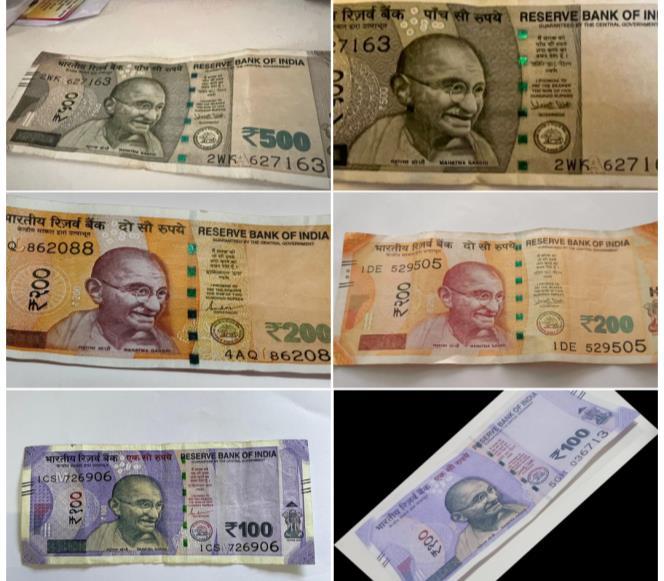
3.2.
Thefeaturesthatwehaveincludedinthisprojectareas follows:
a. AshokaEmblem:
The Ashoka Emblem, based on the Lion Capital of Ashoka,isakeysymbolofIndia’ssovereignty.Itfeatures four lions and the Ashoka Chakra beneath them. It is placedonthefrontofthenote,typicallyontherightside near the watermark window. The fine detailing and embossing make it difficult to replicate, serving as a distinctfeaturetoidentifygenuinecurrency.
b.DevanagariScript:
The Devanagari script is used for printing the denominationofthecurrencynoteinHindi.Itisprinted on the left-hand side of the note. The intricate design is hardtocopy,addinganextralayerofauthenticitytothe currency.
c. SecurityThread:
Thesecurity threadisa visible, embeddedstriprunning through the note, often displaying color-shifting properties or microprinting. It runs vertically along the right-handsideofthenote.Embeddedduringthepapermaking process, it is difficult to replicate and may includeUV-reflectiveproperties.
d. Serial Number:
Each note has a unique serial number consisting of alphabetic characters and digits. It is found on the top left and bottom right of the note. The serial number helps track and differentiate each note, providing a unique anti-counterfeit measure.
e. Promise Clause & Governor’s Signature:
The stamp and the signature located just to the right of the security thread on Indian currency notes belong to theGovernoroftheReserveBankofIndiaandarepartof thePromiseClauseandtheGuaranteeClause.Itisplaced to the right of the security thread and below the "Reserve Bank of India" inscription. The Governor’s signatureisprintedwithprecision,andtheinkusedhas uniqueproperties,makingforgerydifficult.
f.Reserve BankofIndiaInscription:
The "Reserve Bank of India" inscription signifies the issuing authority of the currency and is printed in a standardizedfonttopreventcounterfeiting.Itisprinted at the topmost right corner of the note. The fine detailing, uniform font, and specific ink properties enhancesecurity,preventingduplication.

International Research Journal of Engineering and Technology (IRJET) e-ISSN:2395-0056
Volume: 12 Issue: 05 | May 2025 www.irjet.net p-ISSN:2395-0072
g. DenominationNumeral(100, 200, 500):
The denominationnumeralrepresentsthecurrency’s value and is printed in a distinct font and ink style for easy recognition and security. It is written on the right side of the note. The unique font style, ink pattern, and size variation contribute to its anti-counterfeiting properties,makingiteasytoverifygenuinecurrency.
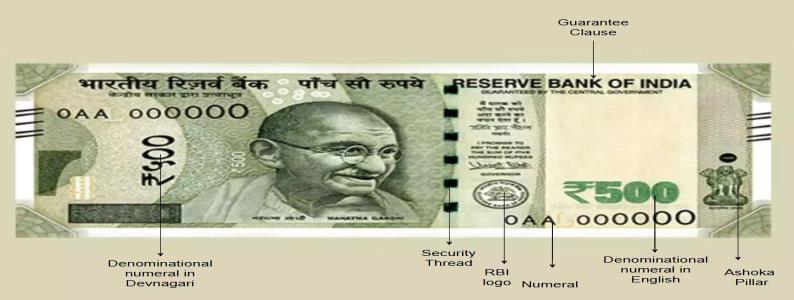
3.3. YOLOV5
YOLOv5isanextremelyeffectiveobjectdetectionmodel that can run on images in real-time and detect and localizeseveral objectsin thescenesimultaneously.The abbreviation "YOLO" means "You Only Look Once," which is the name assigned to the property that the model must only look at the image once to make predictionsofobjectlocationsandclasses.YOLOv5isan advanced object detection model that builds upon the success of previous YOLO versions, introducing new featuresandimprovementstoenhanceperformanceand flexibility. Designed to be fast, accurate, and userfriendly, YOLOv5 is implemented in the PyTorch framework,whichfacilitatesdevelopmentefficiencyand deployment capabilities.(Pytorch) refer [19]. The YOLOv5 model divides an image into a grid and makes predictions of bounding box and class probabilities for each region. It is very fast as opposed to other object detection models that make over one pass or need region proposals. Unlike the conventional method of employing pre-defined anchor boxes for object position predictions, YOLOv5 does away with this limitation and thereforeenablesa moreagileandresponsive detection process.
The proposed Counterfeit Currency Detection System is implemented with a transfer learning scheme based on MobileNetV2asthebackbonefeatureextractor,towhich fine-tuned proprietary classification layers are trained from a multi-class currency dataset. Pre-trained in ImageNet, MobileNetV2 extracts spatially high-level features efficiently through its 17 bottleneck residual blocks, depthwise separable convolutions, and 1×1
pointwise convolutions, hence it is light and efficient to useinmobileandembeddeddevices.Acustomheadfor classification with a Global Average Pooling layer, a 256 ReLU-activatedunitsDenselayer,aDropoutlayerofrate 0.5 to avoid overfitting, and a final Dense layer of six softmax-activated units is used for classifying into six classes:RealandFakedenominationsofRs.100,Rs.200, and Rs. 500. The whole model is fine-tuned with an extremely low learning rate (0.00001) using Adam optimizer and categorical cross-entropy loss, and a ReduceLROnPlateaucallbackforadaptivelyreducingthe learning rate. The resized 400×400 pixel images scaled between 0 and 1 are inputted in batches of 32 to train and validate. The approximately 2.59 million trainable parameter structure possesses low computational complexity at high real versus fake currency discrimination accuracy, thus suitable in resourcelimited,real-timesettings.

E. User Interface:
The proposed system is front-end activation of the user interface of laptops and mobile phones. The HTML, CSS, and JavaScript coded interfaces provide a comfortable experience.Italsocomeswithalivecamerafeaturethat allows users to take photos of currency instructions to instantly review their reliability. To get more inclusiveness, the system also provides audio feedback thatcanbeusedbyvisuallyimpairedusers.Thisfriendly configuration provides excellent and accurate recognition of counterfeit products with a friendly approachtoalargegroupofusers.

International Research Journal of Engineering and Technology (IRJET)
Volume: 12 Issue: 05 | May 2025 www.irjet.net
The proposed system operates through a series of welldefined stages, combining computer vision and deep learning techniques to ensure precise detection and classificationofIndiancurrencynotes.Eachstageplaysa critical role in transforming raw input into actionable insights.
4.1.System Overview
a. InputStage
Thesystemstartswiththe useruploadinganimageof a currency note through a user-friendly front-end interface. Once uploaded, the image undergoes preprocessingstepssuchasresizing,normalization,and format standardization to ensure compatibility with the YOLOv5detectionmodelsee[20].Thesystemisdesigned toacceptimagesinvariousresolutionsandorientations, automatically aligning them for optimal detection performance.
b.Detection Stage
At the core of the detection stage is the YOLOv5 model , trained to identify Indian currency denominations and key security features. This stage involves denomination detection,wherethemodelclassifiesthenoteasINR100, INR200, or INR500 using bounding boxes. Additionally, it performs security feature detection by identifying criticalelementssuchastheAshokaemblem,Devanagari script,numeralfonts,andthesecuritythread.Themodel outputs bounding boxes and confidence scores for each detectedobject,marking their locationandlikelihoodof accuracy.
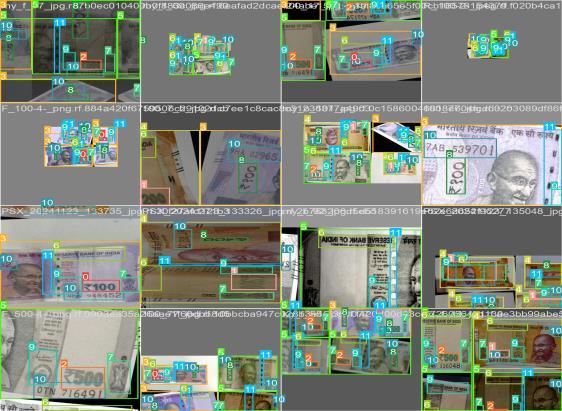

c.ClassificationStage
Oncethefeaturesaredetected,thesystemtransitionsto the classification stage, where each detected feature is cropped and analyzed using a Convolutional Neural Network (CNN) based on MobileNet-V2. MobileNetV2 is a deep learning model optimized for mobile devices (Sandler et al. 234) see[18].The CNN evaluates the integrity of each feature, assessing key elements to determine whether they match genuine currency characteristics. Using these evaluations, the model calculates the likelihood of the currency being genuine orcounterfeit.Designedforrobustness,theclassification model accounts for variations caused by wear and tear, lighting conditions, and slight misalignments, ensuring reliable performance across different scenarios
d.OutputStage
After detection and classification, the system compiles theresultsintoauser-friendlyformat.Visualfeedbackis provided by a label with the classification result (e.g., "Real" or "Fake"),accuracy and note type (e.g.INR100,INR200,INR500) is displayed prominently. Additionally, audio feedback is included, offering a summary of the results in both English and Hindi to enhanceaccessibilityanduserexperience.
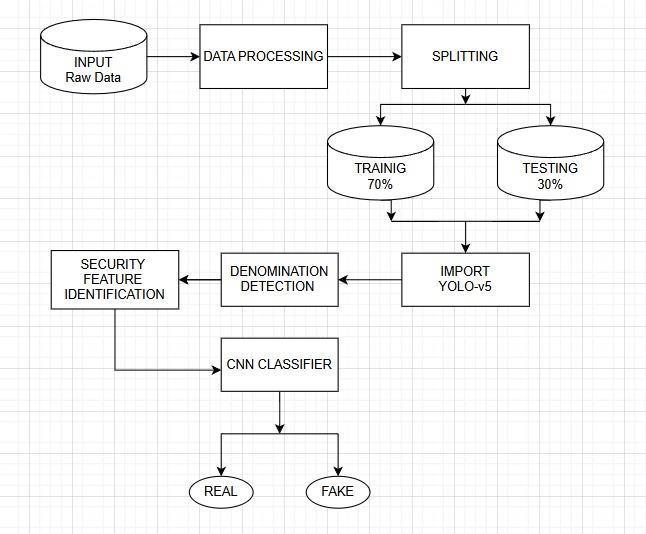

International Research Journal of Engineering and Technology (IRJET) e-ISSN:2395-0056
Volume: 12 Issue: 05 | May 2025 www.irjet.net p-ISSN:2395-0072
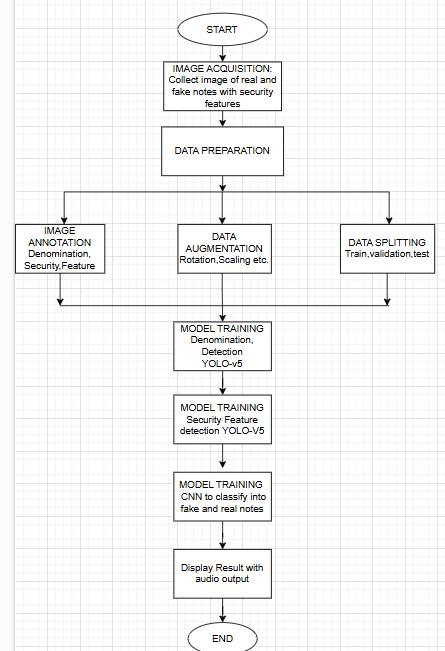
4.2.Hardware
The System requires a well-equipped hardware and software setup for optimal performance. For hardware, an Intel i5/i7 processor (11th generation or higher) is recommended to ensure smooth execution, along with 16 GB RAM to handle computational tasks efficiently. A 256 GB SSD or more is advised for faster data storage and quick access. While a dedicated GPU such as the NVIDIA GTX/RTX series is optional, it can significantly speed up model training and inference. The system should run on Windows 10/11 or higher for compatibilitywiththerequiredsoftware.
On the software side, Roboflow is used for dataset creation and annotation in the YOLO format. The detection and classification of counterfeit currency rely on YOLOv5 for object detection and feature extraction, while MobileNetV2 (CNN) isemployed for classification. The web application interface is built using Django, ensuring a robust and user-friendly platform. DevelopmentiscarriedoutinGoogleColabandVSCode, providing flexibility in model training and coding. The entire system is implemented using Python (version 3.7 orhigher)tointegratevariouscomponentsseamlessly.
LaptopUI:


Result page
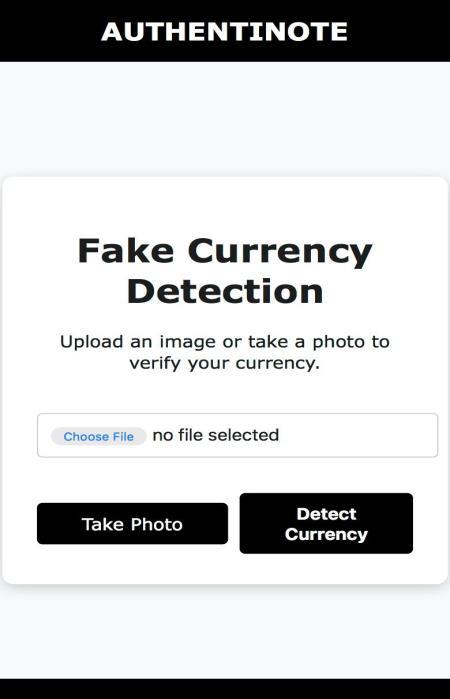
5.3 UIofHomeScreen

International Research Journal of Engineering and Technology (IRJET)
Volume: 12 Issue: 05 | May 2025 www.irjet.net

The performance of the proposed Counterfeit Currency Detection Systemisstrongingeneral with92%training accuracyforsixclasses-RealandFakeRs.100,200,and 500 values. The system is highly accurate, precise, and possesses good F1-scores, particularly for upper denomination classes like Fake 500, which recorded a flawless 1.00 across all the measures and relatively low values were registered for Real 100 (0.73), showing the need for improvementofthisclass.Also,wecreated an untested test dataset with 11 images per class. While undergoingtesting,thesystemrecordedhighaccuracies for the majority of the classes like Real 500 (98.34%), Fake 200 (97.25%), and Fake 100 (96.09%), while Real 200 and Fake 500 also recorded almost perfect ones. Real100 recordedalowaccuracyof59.18%,evidencing still inability to identify this denomination. The Weighted Average and Macro-Average scores of around 0.89 for Precision and F1-Score reflect the excellent balanceinperformanceacrosstheclasses.Theconfusion matrix further reflects the system's classification effectiveness, which points out that even though the model correctly identifies most denominations all the time, its calibration for lower denominations such as Real 100 can further enhance its overall robustness and accuracy.
Table 1: PerformanceMetricsforuntestedtestset
Table 2. AverageAccuracyforuntestedtestset
Confusion Matrix: A Confusion Matrix is a performancemeasuring tool for classifying problems that tests the accuracy of a machine learning model. It is a square matrix comparing the predicted labels with the true labels.Eachrowofthematrixisrelatedtotheinstances in a true class, and each column is related to the instancesinapredictedclass.

International Research Journal of Engineering and Technology (IRJET) e-ISSN:2395-0056
Volume: 12 Issue: 05 | May 2025 www.irjet.net p-ISSN:2395-0072

Chart 1- ConfusionMatrix
PrecisionRecallCurve:Precision-RecallCurveisagraph to measure the performance of a classification model that is relative to imbalanced data with one class significantly more frequent than the other. It is a graph ofPrecisiononthey-axisagainstRecallonthex-axisfor variousvaluesofthethreshold.

Chart 2- Precision-RecallCurve
7. CONCLUSION & FUTURE SCOPE
The AuthentiNote: Counterfeit Currency Detection System provides a smart and efficient way to tackle the growing problem of fake currency. By combining YOLOv5 for detecting key security features and MobileNetV2 for classification, it ensures fast, accurate, and real-time verification of Indian banknotes. We achievedatrainingaccuracyof92%andanuntestedtest set achieved an accuracy of 89%. Unlike traditional methods, which can be slow and error-prone, this system offers higher precision and reliability, making it easier to detect counterfeit notes. Mobile accessibility makes it available even to the common people and the audiofeedback makes it more accessible to the visually impairedpeoplethusensuringinclusivityforall.
Whilethesystemisalreadyeffective,there’salways room for improvement. Expanding the dataset to cover more denominations, currency conversion, enhancing real-time processing can make it even more powerful. With continuous refinement, AuthentiNote has the potentialtobecomeatrustedtoolforbusinesses,banks, andindividuals,helpingtocreateamoresecurefinancial systemand reducingtherisksofcounterfeitcurrencyin everydaytransactions.
[1]“IndianCurrencyNoteRecognitionSystemusing YOLO v3 Methodology” 2021. https://www.irjet.net/archives/V8/i1/IRJETV8I1239.pdf
[2] “Counterfeit Currency Detection Using Machine Learning” 2024. https://www.researchgate.net/publication/381692208_ Counterfeit_Currency_Detection_Using_Machine_Learnin g
[3]“InternationalJournalforResearchinAppliedScFake Currency Detection Using ORB Algorithm” 2021 https://www.ijraset.com/research-paper/fakecurrency-detection-using-orb-algorithm
[4] “Real-time Fake Currency Detection using Deep Learning” 2019. https://www.ijeat.org/wpcontent/uploads/papers/v9i1s5/A10071291S52019.pdf
[5]“DetectionofCounterfeitIndianCurrencyNoteusing Image Processing” 2019. https://www.ijeat.org/wpcontent/uploads/papers/v9i1/A9972109119.pdf
[6]“YOLO-v3 Based Currency Detection for Visually Impaired” 2020. https://www.researchgate.net/publication/340975899_ YOLO-
v3_Based_Currency_Detection_and_Recognition_System_ for_Visually_Impaired_Persons
[7]“DetectionofFakeIndianCurrency Using Deep Convolutional Neural Network” 2023. https://ieeexplore.ieee.org/document/10396993?denie d=
[8]“FakeCurrencyDetectionusingImageProcessing” 2023.
https://ijsrset.com/index.php/home/article/view/IJSRS ET24113139
[9] “Fake Currency Recognition System Using Edge Detection” 2022 IEEE. https://ieeexplore.ieee.org/abstract/document/979154 7

International Research Journal of Engineering and Technology (IRJET) e-ISSN:2395-0056
Volume: 12 Issue: 05 | May 2025 www.irjet.net p-ISSN:2395-0072
[10] “Analysis of Counterfeit Currency Detection Techniques for Classification Model” 2018. https://events.rdias.ac.in/wpcontent/uploads/2021/06/5.-An-Analysis-ofcounterfeit-currency-detection-techniques-forclassification-model-1.pdf
[11] “YOLOv5 based Web Application for Indian Currency Note Detection” 2022 https://www.irjet.net/archives/V9/i4/IRJETV9I4342.pdf
[12]“FakeCurrencyDetectionSystemusingCNN”2020 https://www.irjet.net/archives/V7/i3/IRJETV7I3509.pdf
[13] “DeepCyberDetect: Hybrid AI for Counterfeit Currency Detection with GAN-CNN-RNN using African Buffalo Optimization” 2023 https://thesai.org/Downloads/Volume14No7/Paper_72DeepCyberDetect_Hybrid_AI_for_Counterfeit_Currency_D etection.pdf
[14]“CounterfeitCurrency Detection Using Machine Learning” 2024 https://ijsrset.com/index.php/home/article/view/IJSRS ET24113139
[15]“RealTimeFakeCurrencyNoteDetectionusing Deep Learning” 2019 https://www.ijeat.org/wpcontent/uploads/papers/v9i1s5/A10071291S52019.pd
[16]“DesignSpaceExplorationofaSparseMobileNetV2 Using High-Level Synthesis and Sparse Matrix Techniques on FPGAs” 2022 https://www.researchgate.net/publication/361260658_ Design_Space_Exploration_of_a_Sparse_MobileNetV2_Usi ng_HighLevel_Synthesis_and_Sparse_Matrix_Techniques_on_FPG As
[17] “Counterfeit currency and security documents. Interpol.” 2023 https://www.interpol.int/Crimes/Counterfeit-currencyand-security-documents?utm_source=chatgpt.com
[18]“Sandler,Marketal. MobileNetV2: Inverted Residuals and Linear Bottlenecks. Springer” 2023 https://link.springer.com/
[19] “YOLO-V5 by Ultralytics” 2020 https://pytorch.org/hub/ultralytics_yolov5/?
[20] Yolov5 download https://github.com/ultralytics/yolov5
[21] Reserve Bank of India (RBI). (2023). Annual Report
on Fake Currency Notes Detected in the Banking System. https://rbi.org.in